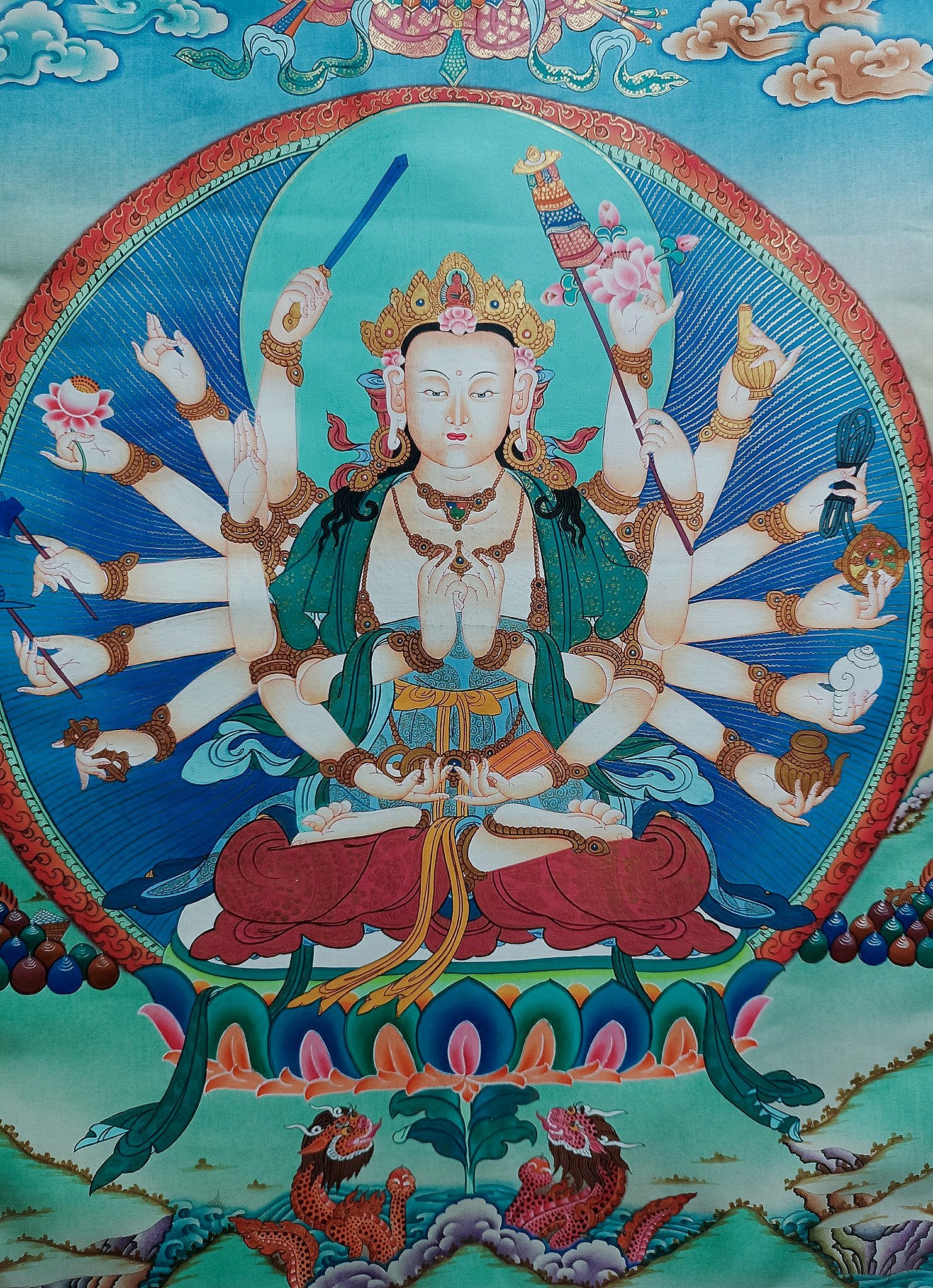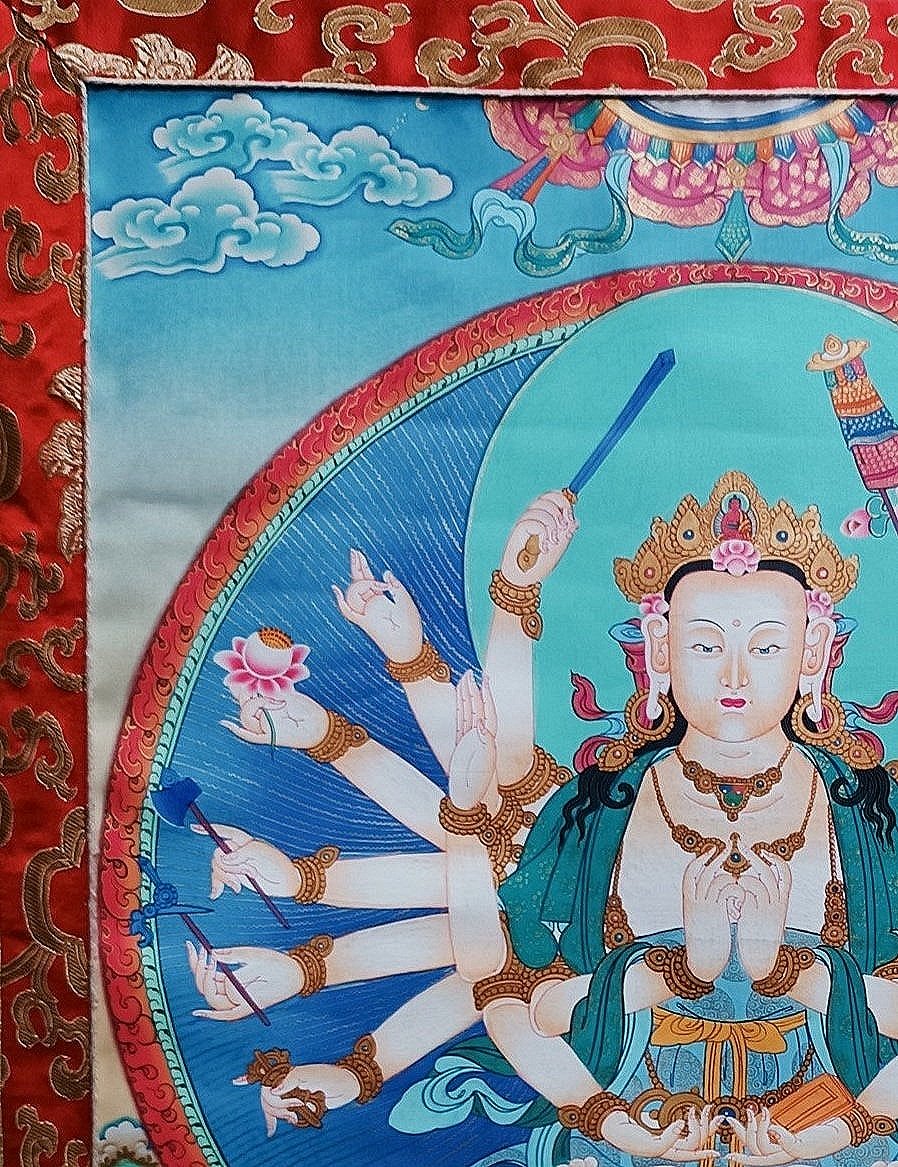 Image 1 of 3
Image 1 of 3

 Image 2 of 3
Image 2 of 3

 Image 3 of 3
Image 3 of 3




Cundī; ལྷ་མོ་སྐུལ་བྱེད་མ།; 準提
Cundi is a key figure in Buddhism. She was a princess who met the Buddha at Kalandakanivapa, where she learned the Cundi Sutta. Cundi, daughter of King Bimbisara, received five hundred chariots, a rare gift shared with Visakha and Princess Sumana. Her brother is Cunda, and she is recognized as a skilled laywoman or upasika. Cundi is associated with the Cundī dharani, which includes a special hand gesture and a circular mirror. She is believed to help cleanse negative karma and enhance spiritual growth, facilitating the path to Buddhahood. Cundi is known by various names, such as Cundavajrī and Saptakoṭi Buddha-bhagavatī, meaning "The Blessed Buddha of the Seventy Million." In Chinese, she is called "Zhunti Buddha Mother," and in Tibetan Buddhism, she is Lhamo Cunda or Chunde, with 'Lhamo' meaning 'Devi' in Sanskrit, highlighting her status as a goddess.
Hand-painted in Nepal.
The natural Pigment Painting measures 20 Inches by 15 Inches, with an additional silk Thangka bordering it.
Cundi is a key figure in Buddhism. She was a princess who met the Buddha at Kalandakanivapa, where she learned the Cundi Sutta. Cundi, daughter of King Bimbisara, received five hundred chariots, a rare gift shared with Visakha and Princess Sumana. Her brother is Cunda, and she is recognized as a skilled laywoman or upasika. Cundi is associated with the Cundī dharani, which includes a special hand gesture and a circular mirror. She is believed to help cleanse negative karma and enhance spiritual growth, facilitating the path to Buddhahood. Cundi is known by various names, such as Cundavajrī and Saptakoṭi Buddha-bhagavatī, meaning "The Blessed Buddha of the Seventy Million." In Chinese, she is called "Zhunti Buddha Mother," and in Tibetan Buddhism, she is Lhamo Cunda or Chunde, with 'Lhamo' meaning 'Devi' in Sanskrit, highlighting her status as a goddess.
Hand-painted in Nepal.
The natural Pigment Painting measures 20 Inches by 15 Inches, with an additional silk Thangka bordering it.
Cundi is a key figure in Buddhism. She was a princess who met the Buddha at Kalandakanivapa, where she learned the Cundi Sutta. Cundi, daughter of King Bimbisara, received five hundred chariots, a rare gift shared with Visakha and Princess Sumana. Her brother is Cunda, and she is recognized as a skilled laywoman or upasika. Cundi is associated with the Cundī dharani, which includes a special hand gesture and a circular mirror. She is believed to help cleanse negative karma and enhance spiritual growth, facilitating the path to Buddhahood. Cundi is known by various names, such as Cundavajrī and Saptakoṭi Buddha-bhagavatī, meaning "The Blessed Buddha of the Seventy Million." In Chinese, she is called "Zhunti Buddha Mother," and in Tibetan Buddhism, she is Lhamo Cunda or Chunde, with 'Lhamo' meaning 'Devi' in Sanskrit, highlighting her status as a goddess.
Hand-painted in Nepal.
The natural Pigment Painting measures 20 Inches by 15 Inches, with an additional silk Thangka bordering it.